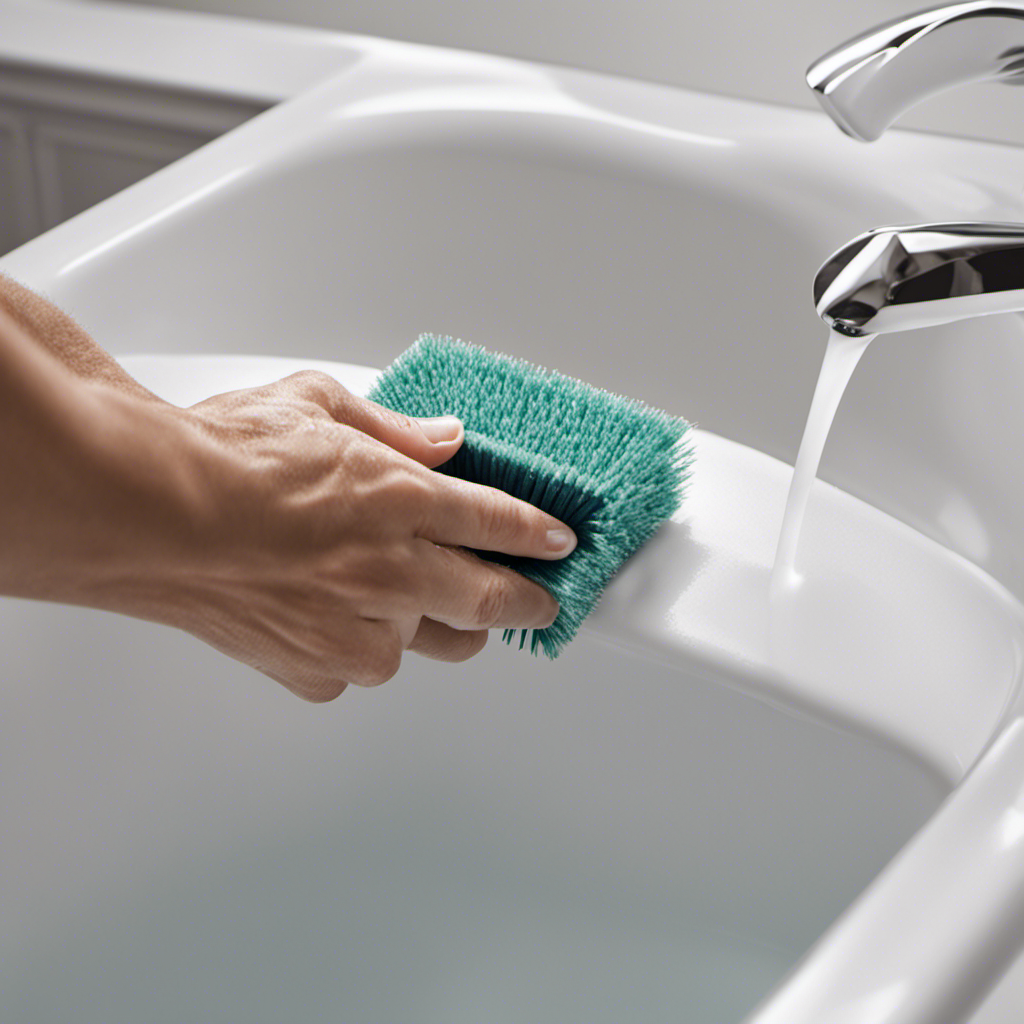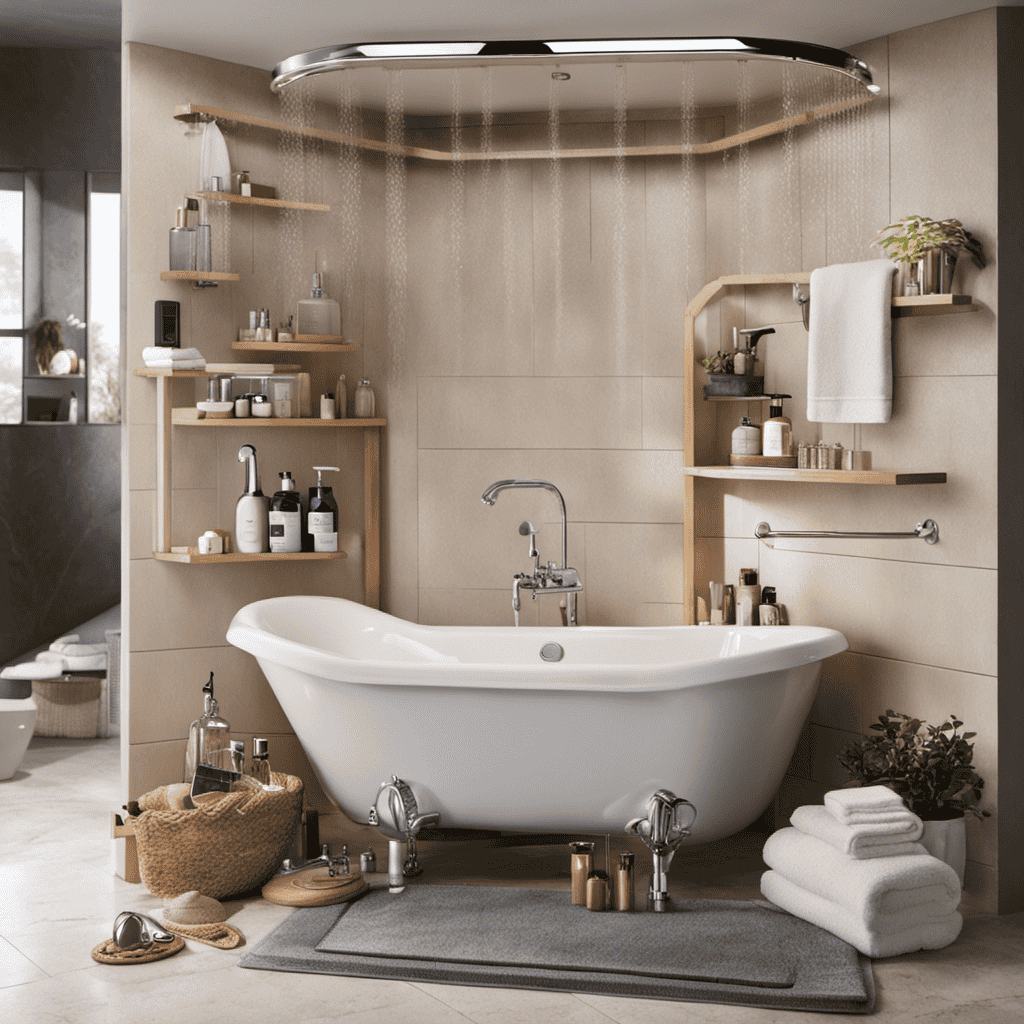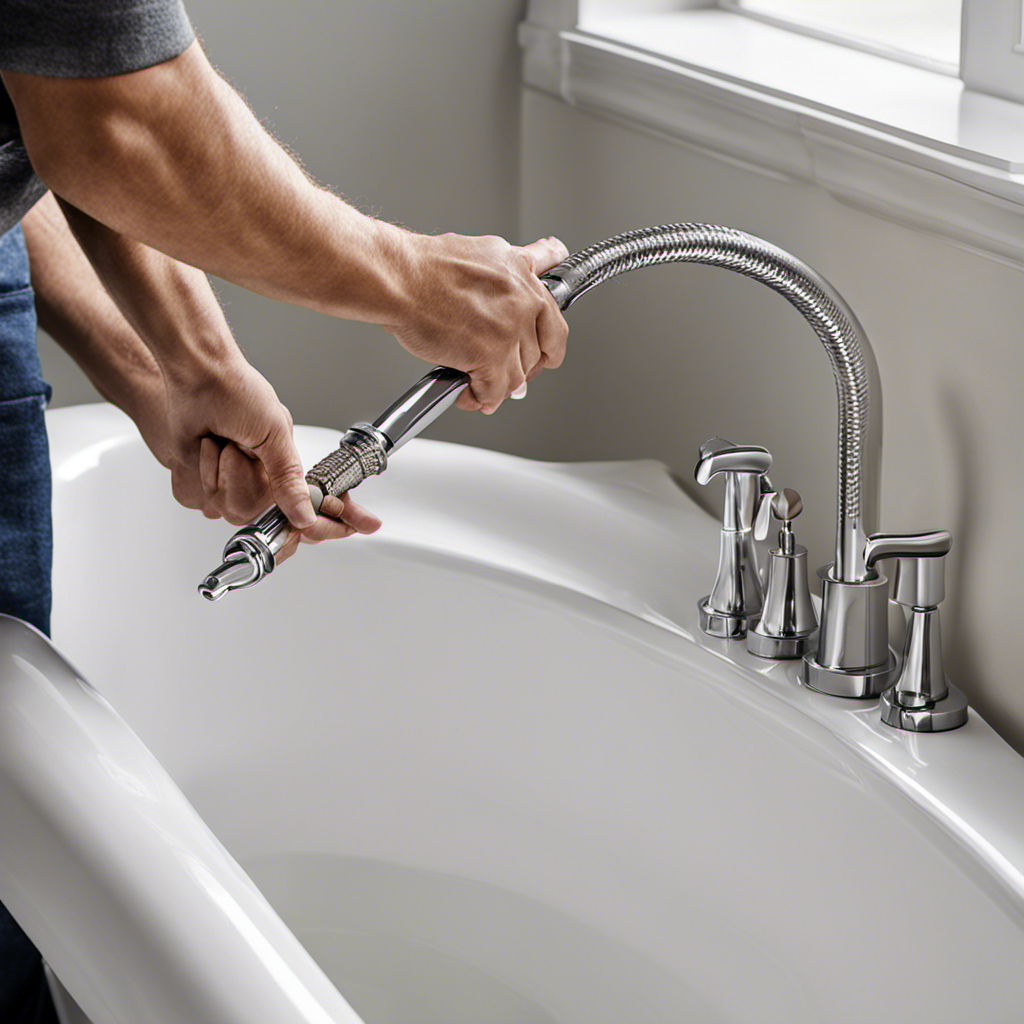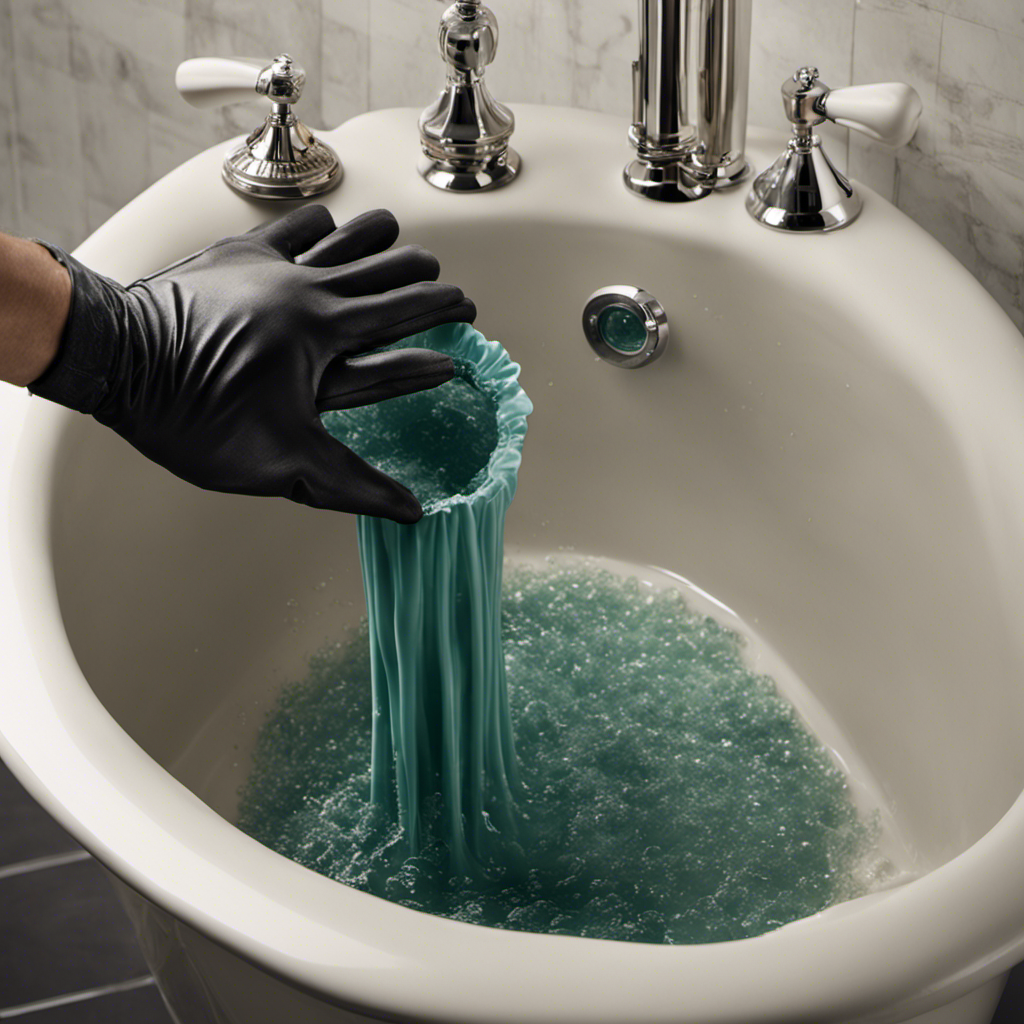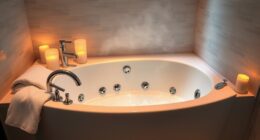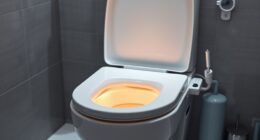Did you know that non-slip bathtub strips can harbor bacteria and become slippery if not cleaned regularly?
In this article, I’ll show you how to effectively clean and maintain these strips to ensure a safe bathing experience.
With just a few simple steps, you can remove dirt and grime, leaving your bathtub strips clean and slip-free.
So let’s dive in and discover the best way to clean non-slip bathtub strips.
Key Takeaways
- Non-slip bathtub strips prevent slips and falls in the tub.
- Essential cleaning supplies include microfiber cloths, all-purpose cleaner, disinfectant, and gloves.
- Proper cleaning technique involves using white vinegar and a soft-bristle brush.
- Preparing the bathtub by clearing it of any items and rinsing it with warm water is important before cleaning the strips.
Understanding Non-Slip Bathtub Strips
Non-slip bathtub strips are designed to prevent slips and falls in the tub. These strips are made from a variety of materials, including rubber, vinyl, or adhesive-backed tape.
The main benefit of using non-slip bathtub strips is that they provide an extra layer of safety, reducing the risk of accidents in the bathroom. These strips create a textured surface that enhances traction, making it easier to maintain balance while standing in the tub.
Additionally, they are easy to install and can be cut to fit any size or shape of the bathtub.
Now that you understand the importance and benefits of non-slip bathtub strips, let’s move on to the next step: gathering the necessary cleaning supplies.
Gathering the Necessary Cleaning Supplies
When it comes to cleaning, having the right supplies is crucial. Essential cleaning supplies include items like microfiber cloths, all-purpose cleaner, disinfectant, and gloves.
Knowing what supplies to have on hand and how to use them properly will ensure that your cleaning efforts are effective and efficient.
Essential Cleaning Supplies
To clean your non-slip bathtub strips, you’ll need some essential cleaning supplies. Here are three items that will help you effectively clean and maintain your bathtub strips:
-
White vinegar: This natural cleaning agent is highly effective in removing dirt, grime, and soap scum from non-slip surfaces without leaving behind any residue or damaging the material.
-
Soft-bristle brush: A soft-bristle brush is the ideal tool for scrubbing the bathtub strips without causing any scratches or damage. It allows you to effectively remove dirt and stains from the textured surface.
-
Microfiber cloth: After scrubbing the strips with vinegar and the brush, use a microfiber cloth to wipe away any remaining residue and leave the strips clean and dry.
Now that you have the necessary cleaning supplies, let’s move on to the proper cleaning technique for non-slip bathtub strips.
Proper Cleaning Technique
Once you have the necessary supplies, start by applying white vinegar to the surface. White vinegar is a powerful cleaning agent that helps to remove dirt, grime, and soap scum from non-slip bathtub strips. Simply pour the vinegar onto a cloth or sponge and gently scrub the strips, making sure to get into all the nooks and crannies.
The acidity of the vinegar helps to break down any buildup and restore the strips to their original non-slip condition. After scrubbing, rinse the strips thoroughly with warm water to remove any remaining vinegar residue.
To maintain the non-slip surface, regular cleaning is essential. It is recommended to clean the strips at least once a week to prevent any buildup and ensure maximum safety in the bathtub.
Preparing the Bathtub for Cleaning
Before starting the cleaning process, make sure the bathtub is properly prepared. Here are the pre-cleaning steps to follow:
-
Clear the bathtub: Remove any items such as toiletries or bath toys from the bathtub to ensure a clear surface for cleaning. This will also prevent any potential damage to these items during the cleaning process.
-
Rinse the tub: Give the bathtub a thorough rinse with warm water to remove any loose dirt or debris. This will make it easier to remove any old cleaning residue later on.
-
Remove old cleaning residue: Use a mild cleaning solution or a mixture of vinegar and water to remove any old cleaning residue from the bathtub surface. Scrub gently with a non-abrasive sponge or cloth to avoid scratching the surface.
Applying the Cleaning Solution to the Strips
When it comes to maintaining a safe and clean environment, two key points to focus on are effective cleaning techniques and preventing slip and falls.
By utilizing the right cleaning products and techniques, you can ensure that surfaces are thoroughly cleaned and free of any potential hazards.
Additionally, implementing preventive measures such as installing non-slip strips or mats can greatly reduce the risk of accidents and injuries.
Effective Cleaning Techniques
To effectively clean non-slip bathtub strips, you’ll need to use a strong cleaning solution and a scrub brush. Here are some effective cleaning techniques to help you get the job done right:
-
Choose effective cleaning products: Look for cleaning solutions specifically designed for removing dirt, grime, and soap scum from non-slip surfaces. These products are formulated to provide a deep clean without damaging the strips.
-
Avoid common cleaning mistakes: One common mistake is using abrasive scrub brushes or harsh chemicals that can cause damage to the strips. Additionally, make sure to thoroughly rinse the strips after cleaning to remove any residue that could make them slippery.
-
Regularly clean and maintain: To keep your non-slip bathtub strips clean and in good condition, it’s important to clean them regularly. Set a cleaning schedule and stick to it to prevent dirt and grime buildup.
Preventing Slip and Falls
Make sure you take steps to prevent slip and falls in the bathroom. It’s important to prioritize safety, especially in an area where accidents can easily occur.
There are several preventive measures you can implement to minimize the risk of slips and falls. Firstly, consider using slip-resistant products such as bath mats or adhesive strips in your bathtub or shower. These products provide additional traction and help to prevent any accidental slips.
Additionally, keep the floor dry and free from any water or spills by using a bath mat outside the tub and wiping up any water immediately. Installing grab bars or handrails near the toilet and bathtub is another effective way to prevent falls, providing stability and support.
Scrubbing and Removing Dirt and Grime
While scrubbing, I always use a mixture of vinegar and baking soda to effectively remove dirt and grime from non-slip bathtub strips. It’s a natural cleaning alternative that works wonders and leaves my tub looking spotless.
Here’s why you should try it too:
-
Environmentally friendly: Using vinegar and baking soda is a great way to avoid harsh chemicals and reduce your carbon footprint.
-
Cost-effective: These common household items are inexpensive and readily available, making them a budget-friendly cleaning solution.
-
Stubborn stain remover: Vinegar’s acidic properties combined with the abrasive power of baking soda make it a potent duo for tackling even the toughest stains.
To use this method, simply mix equal parts vinegar and baking soda to form a paste. Apply it to the non-slip strips, scrub gently with a brush, and rinse thoroughly. You’ll be amazed at how effortlessly the dirt and grime disappear, leaving your bathtub looking fresh and clean.
Rinsing and Drying the Bathtub Strips
After scrubbing away the dirt and grime from the non-slip bathtub strips, the next step is to rinse and dry them properly. Rinsing the strips is crucial to remove any remaining cleaning solution or residue.
There are a few rinsing techniques that you can use:
-
Water Hose: Use a water hose to rinse the strips thoroughly. Direct the water flow across the strips to ensure all the cleaning solution is washed away.
-
Bucket and Water: Fill a bucket with clean water and dip a sponge or cloth into it. Wring out the excess water and wipe down the strips to remove any remaining residue.
Once the rinsing is done, it’s important to dry the bathtub strips properly to prevent mold or mildew growth. Here are some effective drying methods:
-
Air Drying: Allow the strips to air dry naturally. Ensure proper ventilation in the bathroom to speed up the drying process.
-
Towel Drying: Use a clean towel to gently pat the strips dry. Avoid rubbing vigorously as it may damage the non-slip surface.
Maintaining the Cleanliness of Non-Slip Bathtub Strips
To maintain the cleanliness of your non-slip bathtub strips, it’s important to regularly rinse and dry them using the techniques and methods mentioned earlier. However, there are additional cleaning tips that can help keep your bathtub strips in pristine condition.
Here are three effective ways to remove stains and prevent buildup on your non-slip strips:
-
Vinegar Solution: Create a mixture of equal parts white vinegar and water. Apply this solution to the stained areas and let it sit for a few minutes. Scrub the strips gently with a soft brush or sponge and rinse thoroughly.
-
Baking Soda Paste: Make a paste by mixing baking soda with water. Apply this paste to the stains and let it sit for about 15 minutes. Scrub the strips gently and rinse well.
-
Lemon Juice: Squeeze fresh lemon juice onto the stained areas and let it sit for a few minutes. Scrub the strips gently and rinse with water.
Conclusion
In conclusion, cleaning non-slip bathtub strips is a simple yet important task to maintain a safe and hygienic bathing environment. By understanding the purpose of these strips and gathering the necessary cleaning supplies, we can effectively remove dirt and grime from our bathtub surfaces.
Through scrubbing, rinsing, and drying, we ensure that our non-slip strips remain clean and functional. By consistently maintaining the cleanliness of these strips, we can prevent accidents and create a comfortable bathing experience.
So, let’s keep our non-slip bathtub strips clean for a safer and more enjoyable bathing time.
